Barbara Foster, The Microscopy & Imaging Place Inc.; and Lars Dugaiczyk, Ushio America Inc.
Fluorescence microscopy
presents an array of illumination challenges. Key among these is matching the spectrum
of the light source to the fluorophore in the sample, to the bulb alignment and
lifetime, and to the evenness of illumination.
A new lamp that optimizes many of these issues has been designed
by veteran bulb designer Ushio America Inc. of Irvine, Calif. Derived from its breakthrough
EmArc technology (Figure 1), the lamp integrates a very short arc, DC-enhanced metal
halide light source with an integrated reflector assembly, optimizing the optics
so that the lamp requires no alignment. The results are a more economical bright
light source that produces even illumination, spectral capability comparable to
that of other mercury arc sources and a bulb life well in excess of 1000 hours.
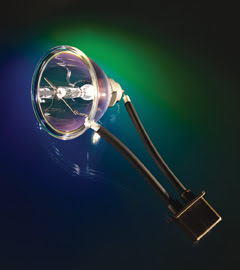
Figure 1. Shown is the 75-W EmArc long-focal-length lamp for fluorescence microscopy.
Challenges in existing systems
The gold standard for light sources for fluorescence microscopy
today is the 100-W mercury arc lamp. This lamp is attached to the microscope via
a housing fitted with a collector lens in front of the bulb for focus and, for enhanced
illumination, a small concave mirror behind the arc that reflects additional intensity
forward. In actual fact, this system has very poor collection efficiency, requires
periodic realignment of the lamp and mirror system and, of more concern, produces
a nonuniform field of illumination.
To align the system to the microscope, the microscope is set up
for Koehler illumination using a high-numerical-aperture objective focused on a
well-behaved slide (a thin section with good contrast). The slide is then replaced
with a blank surface, such as the back of a business card, and the objective turret
is rotated to an open position (no objective). The image of the arc source is focused
on the blank surface using the lamp collector lens and is centered using the X and
Y screws (which control actual lamp placement) on the lamp house. The process is
repeated for the mirror image of the source, using the focus and centration controls
for the rear reflector. Depending upon the microscope manufacturer, the direct image
and the mirror image are either aligned side by side or superimposed.
If left in this state when an objective is rotated back into position
for imaging, the bright spot at the cathode tip of the lamp produces a very hot
spot in the center of the field of view, generating two serious problems. First,
the hot spot enhances localized photobleaching. Second, the uneven illumination
produces falloff at the image edges, making accurate quantitation difficult. To
remedy this, the image of the arc source is typically blurred by defocusing it.
However, blurring diminishes intensity and, if the full alignment is not done meticulously,
still results in uneven illumination.
One solution is to increase the lamp wattage. However, arc lamps
introduce unwanted heat near the delicate optics (even 100-W mercury arc lamps are
known for burning holes through more delicate components such as polarizers), and,
although 100-W mercury arc lamps can be convection-cooled, higher-wattage lamps
require a fan that can transfer vibration to the microscope, destabilizing the image,
especially at high magnification.
A second solution involves using a remote illuminator-coupled
microscope via a fiber lightguide. Light sources used in this approach are typically
very high pressure AC or DC arc lamps prealigned in an elliptical reflector. These
sources produce a bright, uniform image and do not require alignment, but there
is significant loss of efficiency both through the lightguide and the optical coupling
to the microscope.
New engineering approach
The 75-W EmArc long-focal-length system incorporates a number
of new engineering tactics. Its light sources are DC-enhanced metal-halide arc lamps
with very short arc gaps (Figure 1). The short gap enhances overall brightness,
comparing favorably to traditional 100-W mercury arc or xenon in intensity while
using a lower wattage. Because mercury is used in the metal halide, the new lamp
enables all the commonly used mercury arc peaks (Figure 2).
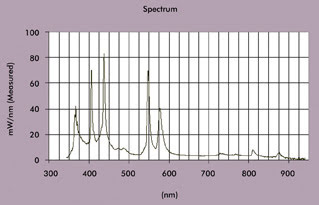
Figure 2. The 75-W EmArc spectrum contains all the commonly used mercury spectral peaks
with a rated lifetime in excess of 1000 hours.
The system’s unique hybrid gas technology ensures that
it is not under internal high pressure when cold, making it much safer to handle.
Precise gas-filling control coupled with the electrode design produces a tightly
confined, stable plasma discharge, minimizing color temperature drift over its lifetime
and dramatically extending bulb lifetime. Typical 100-W mercury arcs are rated for
200 to 300 hours, while the 75-W EmArc is rated for 1000-plus hours. (Laboratory
tests show that the 75-W source retains 60 percent of its intensity, even at 2000
hours.)
Proprietary EmArc DC technology requires a simpler power supply,
making the lamps less expensive at the buying stage. And because they are 75- versus
100-W sources, they are more economical to operate throughout their lifetime. The
same technology also provides tunability, a fairly recent development for arc lamps.
And again, because the lamp runs cooler, there is no need for
a heat sink, and there is less infrared in the spectrum to contribute to unwanted
background. The lower thermal load generates less strain on the illumination/microscope
system, simplifying lamp house design and, again, bringing down the cost.
The reflector assembly is a key differentiating factor for this
lamp. A low-numerical-aperture compound elliptical reflector with the long focal
length required specifically for microscopy, it has been designed not only to be
very durable but to provide a highly efficient light path, as shown by the results
below.
Plug-and-play design
In the past, each time an arc source had to be replaced, the new
lamp required the centering and focusing described above, a process that can be
frustrating at best and, with a rated bulb lifetime typically on the order of 200
hours, time-consuming. (If a typical lamp is used eight hours per day, bulbs must
be replaced approximately every five to six weeks.)

Figure 3. This diagram is of an optical test setup. All test diagrams,
images and results are courtesy of Lars Dugaiczyk, Ushio America Inc.
Furthermore, as fluorescence microscopy expands out of the research
lab and into secondary markets such as the clinical arena, it is being used by less
sophisticated operators, presenting further challenges: Mercury arcs are high-pressure
sources that require gentle, knowledgeable handling and safety precautions, including
safety glasses to guard against explosion and cotton gloves to avoid fingerprints
on the glass envelope. Under the thermal strain of daily use, fingerprints can weaken
the envelope and, again, lead to lamp failure.
In contrast, the 75-W lamp offers a simple plug-and-play design.
The lamp and reflector are integrated, so there is no alignment of direct image
to mirror image. Simply rotate the objective turret to an open space and focus the
lamp image at the specimen plane. With a rated lifetime in excess of 1000 hours,
lamp replacement drops to one-quarter to one-fifth as often, compared with more
traditional sources.
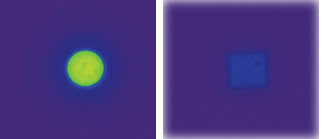
Figure 4. These results compare (a) the 200-W fiber optic illuminator
with (b) the 46-W LED array.
Comparing apples to apples
To test its performance against other widely used illumination
systems, an optical bench was set up (Figure 3) using the range of illuminators
listed in the table. Each light source was placed so that the image of the 25-mm
aperture plate could be focused on an opal glass diffuser, similar to the illumination
expected at the sample plane of a fluorescence microscope. A Lumetrix camera collected
the image formed on the opal glass, and all images were taken with the same pseudocolor
histogram settings. Red indicates higher luminance.
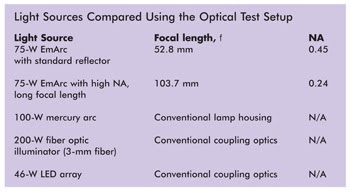 Comparing the results for the 200-W fiber optic illuminator and
the 46-W LED array (Figure 4) with those of the other three sources (Figures 5 and
6) reveals that, although they both produce very even illumination, they are not
very efficient.
Comparing the results for the 200-W fiber optic illuminator and
the 46-W LED array (Figure 4) with those of the other three sources (Figures 5 and
6) reveals that, although they both produce very even illumination, they are not
very efficient.
As evaluated by both the intensity maps and intensity output graph
in Figure 5, when the optical setup is tuned for maximum output, the 75-W long focal
length performs well in comparison with the traditional 100-W mercury arc and outperforms
its standard counterpart. When the setup is tuned for optimum uniformity (Figure
6), the 75 W outperforms the traditional mercury source. Field uniformity is especially
important in tissue applications and provides a consistent background, essential
for even simple quantitation such as automated cell counting and sizing.
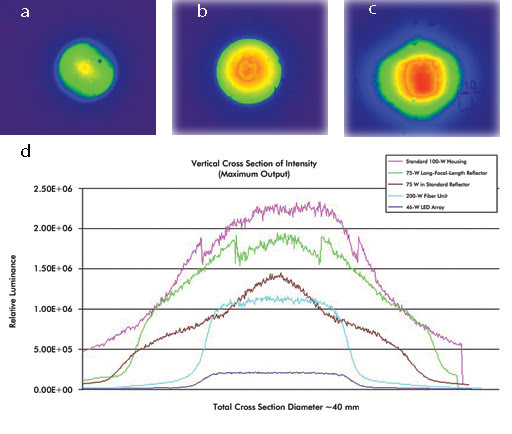 Figure 5. Adjusted for maximum output, (a) the 75-W EmArc/standard
reflector, (b) the 75-W EmArc long-focal-length reflector and (c) a standard 100-W
mercury arc. (d) Comparison of vertical cross section of intensity, set for maximum
output, reveals that the 75-W long-focal-length lamp is a strong second to the 100-W
mercury arc.
Figure 5. Adjusted for maximum output, (a) the 75-W EmArc/standard
reflector, (b) the 75-W EmArc long-focal-length reflector and (c) a standard 100-W
mercury arc. (d) Comparison of vertical cross section of intensity, set for maximum
output, reveals that the 75-W long-focal-length lamp is a strong second to the 100-W
mercury arc.
For decades, the 100-W mercury arc has been the gold standard
for illumination for fluorescence microscopy in cell and tissue applications as
well as for genomics and proteomics. With the rise of new lamp housings, liquid
lightguides and LED sources have seen active innovation in this area over the past
10 years. As the next step in lamp evolution, the new 75-W EmArc provides a unique
mix of safe, high-intensity, even illumination. Easy to use, it satisfies both the
needs of today’s researchers and the future needs of more routine users in
the expanding clinical fluorescence market.
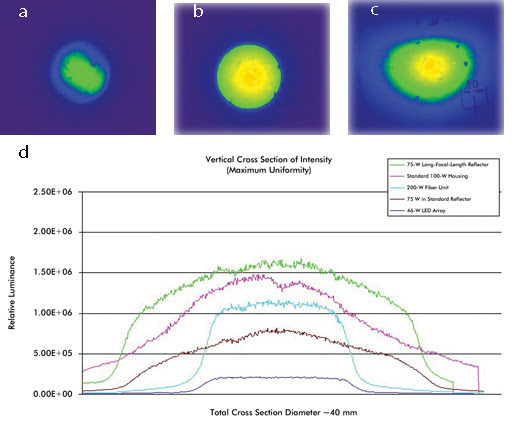 Figure 6. Adjusted for maximum uniformity, (a) the 75-W EmArc/standard reflector, (b) the
75-W EmArc long-focal-length reflector, and (c) a standard mercury arc. (d) Comparison
of vertical cross section of intensity, set for maximum uniformity. Both the intensity
maps on the left and the graph on the right confirm that the 75-W long-focal-length
lamp produces more even illumination across a wider area than does the 100-W mercury
arc.
Figure 6. Adjusted for maximum uniformity, (a) the 75-W EmArc/standard reflector, (b) the
75-W EmArc long-focal-length reflector, and (c) a standard mercury arc. (d) Comparison
of vertical cross section of intensity, set for maximum uniformity. Both the intensity
maps on the left and the graph on the right confirm that the 75-W long-focal-length
lamp produces more even illumination across a wider area than does the 100-W mercury
arc.
Meet the author
Barbara Foster is president and chief strategic consultant at
The Microscopy & Imaging Place Inc. in McKinney, Texas; e-mail: [email protected].
Lars Dugaiczyk is an engineer at Ushio America Inc.; e-mail: [email protected].
Technical questions may be addressed to Keith Cordero, director of applications
engineering, Ushio America Inc.; e-mail: [email protected].